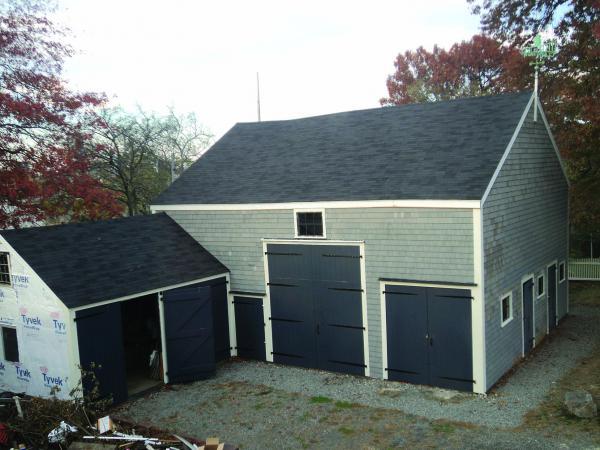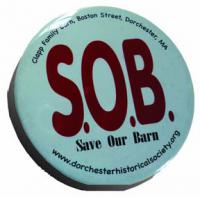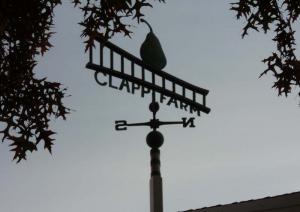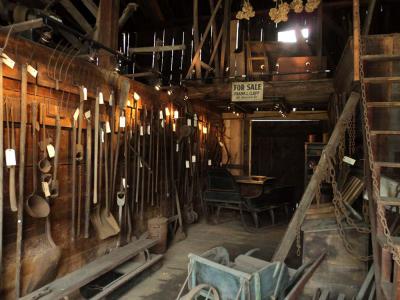September 4, 2014

The Clapp Family Barn, owned by the Dorchester Historical Society, has been carefully restored in recent years, earning the DHS an award from the Boston Preservation Alliance. Photo by Peggy Mullen
Two Dorchester organizations have been chosen to receive Preservation Achievement Awards by the Boston Preservation Alliance (BPA). First Parish Church and the Dorchester Historical Society will accept the awards at a ceremony in October at Faneuil Hall.
Past recipients of the award include Fenway Park, Trinity Church, the Paramount Center, and the Isabella Stewart Gardner Museum.
Greg Galer, executive director of the BPA, said the goal of the awards is to recognize good quality preservation work as well as new construction that is in harmony with the area.
“We’re not a government organization and we have no official regulatory power. We work through the power of advocacy and education with communities, neighborhoods and individual citizens,” said Galer.
Member organizations make nominations for the award. The architectural firm for First Parish, McKinley, Kaslow and Associates, nominated the church. DHS is a member organization of BPA, and nominated one of its properties, the Clapp Family Barn.
“Members of the committee, which is made up of architects, developers, and preservation professionals, will go out to the nominated sites,” said Galer. “We look at the quality of the work, if it fits our mission, and the goals of the project and the outcome.”
In this two-part series, The Dorchester Reporter will tell the stories from the perspective of the community people involved in the process. We begin with Dorchester Historical Society’s Clapp Family Barn.
The DHS project was chosen because of how rare it is to see an effort being made to save a 19th century barn.
“The Clapp Barn is an example of the type of building we’re losing, because they have the least maintenance over time and so tend to go first. But to have someone go and restore it is a real achievement. Most people would give up on a rotted sill, but not this group,” said Galer.
THE CLAPP FAMILY BARN
It has been seven long years since the work on the Clapp Family Barn began, and tenacity best describes the attitude of Earl Taylor, DHS board president. When in the early part of the decade, the tide of deterioration at the Clapp Family Barn seemed impossible to stem, Taylor did not despair.
“I don’t think it’s in my nature to feel that way,” said Taylor. “In my mind, it was only a matter of time. Whether it takes three, 10 or 20 years, I never doubted it would get done.”
Taylor’s persona of quiet confidence and modesty is in sharp contrast to the enthusiasm and ever-ready laugh of DHS vice president, Paul Delorey.
“When I first went inside the barn with a flashlight in 2007 I thought, wow, this is a disaster! But when I came out, I thought we’ve got to save this thing, although I had no idea how.”
Both Taylor and Delorey credit former DHS board member Marcia Sewall for raising consciousness about the value of the barn and the need for action.
“Marcia was an inspiration in the beginning,” said Taylor, “as was former caretaker and board member Jim Cooke, who kept saying we had to do something. We all knew something had to be done, but they brought it to the forefront. That’s when the board switched into barn mode. Jeff Gonyeau (DHS board member) was also a great resource in finding an engineer to draw up the specifications.”
The first hurdle to was to clean out the barn. Over the years it had become a place to store things – old lawn equipment, display cases, furniture and other odds and ends. It had also become a home for feral cats and other members of the animal kingdom.
“We had our dumpster days,” said Taylor. “We had to triage the contents of the barn.”
“I think we filled four dumpsters just cleaning it out. You could hardly walk in there,” said Delorey.
The feeling of satisfaction that follows a good clean out faded quickly when the group began to grapple with the biggest challenge to save the structure - money. Before the money can be raised, there must be the will to see the project happen.
It’s easy to confuse the terms restoration and renovation. Renovation involves making an object look like new. Restoration is to return an object to its original state, and that costs a lot more money, time and care.
To restore the Clapp Family Barn, the first problem to be dealt with was its massive structural problems. The roof was leaking. The doors were falling off. The sill was rotted. And these things that were obvious to even the untrained eye were only the beginning.
Taylor said there were many other problems.
“We uncovered some totally rotten beams, and never knew we could’ve been killed walking into the place time and again, as we did. Once the professionals opened it up, we could see it. It’s astounding to think the building still stands. I found it really exciting to see the actual structure of the building when it was opened up by the professionals, and then finally fixed.”
An earlier facilities assessment and long-range plan, commissioned by the DHS board, estimated the cost to restore the barn to be in the neighborhood of a half-million dollars.
As the DHS board considered the scale of the project, Taylor was concerned that there would be less enthusiasm to give money to the effort after the successful project to restore the James Blake House on Columbia Road, one of three house museums owned by the society.
“When we started working on this more pedestrian building, I didn’t think the same pitch would do. And yet, the truth was you can’t not do anything. We had to do something,” he said.
 S.O.B. pinSo they began a fundraising campaign called Save Our Barn. Dubbed S.O.B. by former board member Dan Cushing, lapel buttons were made and distributed as a first step toward raising awareness, and appeal letters went out to the general membership. Many generous members responded, and a number of events followed.
S.O.B. pinSo they began a fundraising campaign called Save Our Barn. Dubbed S.O.B. by former board member Dan Cushing, lapel buttons were made and distributed as a first step toward raising awareness, and appeal letters went out to the general membership. Many generous members responded, and a number of events followed.
In 2007 the group held a comedy fundraiser with nationally-known comic Jimmy Tingle. In 2008-9, DHS took advantage of its own history and partnered with the Boston Winery to make pear and apple wine. Clapp’s Favorite Pear – which inspired the sculpture in Edward Everett Square - was developed on the Boston Street farm. In 2010, the organization held a gala fundraiser on the grounds of the property, where more than 150 people gathered under a tent to enjoy dinner, served with Dorchester-made wine. In 2012 another large fundraising dinner was held at the Venezia Restaurant.
During the 2010 fundraiser, DHS was able to allow limited access to the barn, where Delorey spent many hours curating an exhibit of farm tools.
“Paul’s organizational skills have been key,” Taylor said.
“Earl found journals from the 1850s, and that’s how I was able to identify the tools in the barn. They’re all English in origin and they’re all original,” said Delorey.
Taylor said that just over $200,000 has been spent on the project.
“There was a grant from a city organization called Partners with Nonprofits of $25,000, but the rest was all private donations,” said Taylor. “We even managed to fix part of our carriage house, too.”
 Clapp Family Barn Weathervane
Clapp Family Barn Weathervane
DHS had to be cognizant of saving as much as they could, but thoughtful about where the savings were made.
“When we did replace parts of the barn, it had to be with like kinds of materials. We replaced oak with oak. But some things are modern. For example, we have some iron rods holding the building together that were not there before, but there are not a lot of things that are new,” said Taylor.
“It was an interesting process. You see what you think you can afford, and get that much done, but then a contractor says I’ll give you a deal if we can do that piece, too. This happened three or four times with the barn. And we were excellent at negotiating, and we got volunteer work, too.”
A lot of the hands-on volunteer work was done by Delorey.
“When I retired, I had the time to donate. I was super interested in the project and felt very enthusiastic about it, so I was happy to save the society money by being the carpenter’s apprentice. I learned a lot about carpentry and building techniques, and I’ve had a lot of fun doing it.”
The enormity of the achievement is made even more remarkable because the entire project was conceived and carried out by an all-volunteer organization. Except for the building professionals, no one else involved with the project ever got a cent. Members from all over Dorchester and beyond, from all walks of life – homemakers, artists, teachers, lawyers, nurses, business people, scientists, realtors, writers - some who are native, others transplants, have given time, care and money to see the project through.
 A view inside the refurbished Clapp Family Barn: Tools from Dorchester's agricultural past. Photo by Peggy MullenMembers of the board of directors gave of their time and talent over the long history of the project, from fundraising committee meetings, personal donations, as well as long and hard decision making sessions about the budget. For three years, a Farm Day event was organized in conjunction with the Roger Clapp School, complete with pony rides, and aimed at a younger audience in the hopes of generating enthusiasm about the building and its contents.
A view inside the refurbished Clapp Family Barn: Tools from Dorchester's agricultural past. Photo by Peggy MullenMembers of the board of directors gave of their time and talent over the long history of the project, from fundraising committee meetings, personal donations, as well as long and hard decision making sessions about the budget. For three years, a Farm Day event was organized in conjunction with the Roger Clapp School, complete with pony rides, and aimed at a younger audience in the hopes of generating enthusiasm about the building and its contents.
Delorey and Taylor are gratified by the progress so far, and while the project is mostly finished, there are still things that need to be done.
“Two doors on the north side must be restored,” said Delorey, “and there’s another door and a couple windows that need work. And during the process, Earl discovered a set of stairs to the lower level that had been completely covered up. We didn’t know they were there. ”
Taylor said if the vision is to use the space for programs, then a good deal needs to be done to set up exhibits. “I don’t mean adding plaster walls. It’s an unfinished building, because it housed tools and animals, which is part of its character and charm. But there’s a full basement with lots of head height and it could be adapted for storage.”
DHS is holding a fundraiser on Sept. 26 on the grounds of the Boston Street property. An evening at Willow Court – the original name of the Lemuel Clap House — will include a celebratory dinner under a tent, and access to the barn and other exhibits. Participants are being encouraged to dress in period costume, circa late 1800s-early 1900s. A photographer will document the event for posterity. Tickets and information are available at dorchesterhistoricalsociety.org.
The second installment in this series— focusing on the First Parish Church project— will appear in an upcoming edition of The Reporter.
Villages:
Topics:


